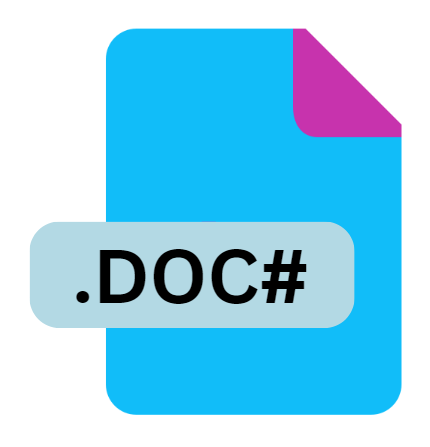.DOC# File Extension

LibreOffice Document Lock File
| Developer | LibreOffice |
| Popularity | |
| Category | Misc Files |
| Format | .DOC# |
| Cross Platform | Update Soon |
What is an DOC# file?
The .DOC# file extension is associated with LibreOffice, a popular open-source office suite that provides tools for word processing, spreadsheets, presentations, and more.
In particular, .DOC# files are lock files created by LibreOffice to manage document editing and prevent conflicts when multiple users are working on the same document.
These files play a crucial role in maintaining data integrity and ensuring a smooth collaborative editing experience.
More Information.
LibreOffice, originally forked from OpenOffice.org in 2010, aimed to improve and extend the capabilities of its predecessor.
As part of its efforts to offer a reliable and user-friendly office suite, LibreOffice introduced mechanisms to handle simultaneous editing and ensure document consistency.
The .DOC# file format was developed as a lock file to prevent conflicts when a document is opened for editing by multiple users or applications.
The initial purpose of the .DOC# file was to serve as a temporary lock file that indicates the document is currently being edited.
This is essential in collaborative environments where multiple users might try to edit the same file simultaneously.
By using lock files, LibreOffice ensures that only one user can make changes at a time, thereby reducing the risk of data loss or corruption.
Origin Of This File.
The .DOC# file extension is specific to LibreOffice, a successor to the OpenOffice.org project. LibreOffice was developed by The Document Foundation to provide a free, open-source office suite with functionality comparable to commercial offerings like Microsoft Office.
The .DOC# files are part of LibreOffice’s document management system, which includes various file types to handle different aspects of document handling, including temporary files and backup files.
File Structure Technical Specification.
The .DOC# file is a binary file generated by LibreOffice to manage document locking. While the specific internal structure of the .DOC# file is not publicly documented in detail, its function is relatively straightforward.
The file contains metadata that indicates the document’s lock status, including information about the user currently editing the document and the time of the last modification.
The file structure of .DOC# files is designed to be minimal, focusing primarily on providing the necessary locking mechanism rather than storing extensive data.
This lightweight design helps ensure that the lock file does not impact the performance of the LibreOffice suite or the document being edited.
How to Convert the File?
Converting a .DOC# file to other formats, such as .DOCX or PDF, can be necessary for better compatibility or to share documents more widely. To convert a .DOC# file, you can use the following methods:
- Microsoft Word: Open the .DOC# file in a compatible version of Microsoft Word and use the “Save As” feature to convert it to a more common format like .DOCX or PDF.
- Online Converters: Various online tools offer conversion services for .DOC# files. Upload the file to the converter, select the desired output format, and download the converted file.
- Third-Party Software: Specialized software can convert .DOC# files to other formats, offering additional features like batch conversion or advanced formatting options.
Advantages And Disadvantages.
Advantages:
- Prevents Conflicts: The primary advantage of .DOC# files is their ability to prevent editing conflicts. By creating a lock file, LibreOffice ensures that multiple users do not overwrite each other’s changes, maintaining document integrity.
- Collaborative Editing: In collaborative environments, .DOC# files are crucial for enabling multiple users to work on a document while preventing simultaneous modifications that could lead to data loss.
- Temporary Nature: The lock files are temporary and automatically removed when the document is closed properly. This reduces the risk of lingering lock files that could interfere with future edits.
Disadvantages:
- File Clutter: In some cases, improperly closed documents or application crashes can leave behind .DOC# files, which may accumulate and clutter the directory where documents are stored.
- Potential Confusion: Users unfamiliar with LibreOffice’s file management system may be confused by the presence of .DOC# files, mistaking them for essential documents or backup files.
- File Management: Handling and managing lock files can be a bit cumbersome for users who need to manually remove leftover .DOC# files after an unexpected application shutdown.
How to Open DOC#?
Open In Windows
- LibreOffice Handling: LibreOffice automatically manages .DOC# files when you open and edit documents. There is no need to manually open .DOC# files; they are managed internally by the application.
- File Explorer: If you encounter .DOC# files in File Explorer, you can safely ignore or delete them if they are leftover from improperly closed documents. Ensure that LibreOffice is closed before deleting these files to avoid conflicts.
Open In Linux
- LibreOffice Handling: On Linux, LibreOffice manages .DOC# files in the same way as on other operating systems. There is no need to open or edit these files manually.
- File Managers: Use your preferred file manager to view and delete .DOC# files if necessary. Be cautious to close LibreOffice before making changes to avoid potential data conflicts.
Open In MAC
- LibreOffice Handling: Similar to Windows, LibreOffice on macOS handles .DOC# files internally. Users do not need to interact with these files directly.
- Finder: .DOC# files can be seen in Finder if they are present. They can be deleted manually if needed, but ensure LibreOffice is not running to avoid potential issues.











